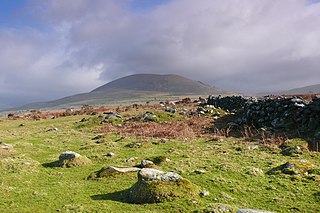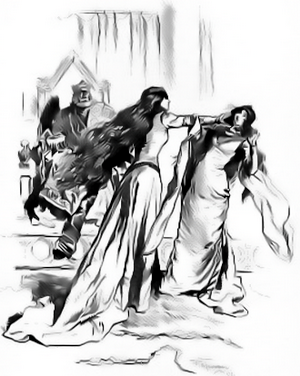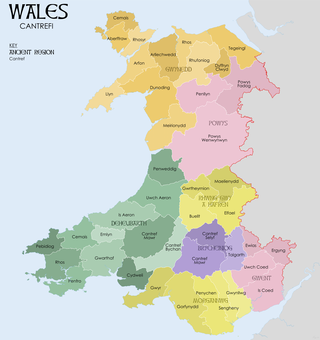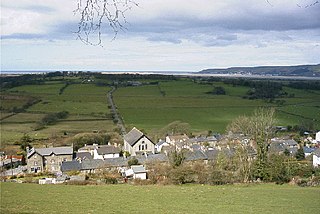Related Research Articles

Gwyn ap Nudd is a Welsh mythological figure, the king of the Tylwyth Teg or "fair folk" and ruler of the Welsh Otherworld, Annwn, and whose name means “Gwyn, son of Nudd”. Described later on as a great warrior with a "blackened face", Gwyn is intimately associated with the otherworld in medieval Welsh literature, and is associated with the international tradition of the Wild Hunt.

Brân the Blessed is a giant and king of Britain in Welsh mythology. He appears in several of the Welsh Triads, but his most significant role is in the Second Branch of the Mabinogi, Branwen ferch Llŷr. He is a son of Llŷr and Penarddun, and the brother of Brânwen, Manawydan, Nisien and Efnysien. The name "Brân" in Welsh is usually translated as crow or raven.
In Welsh mythology, Elffin ap Gwyddno was a son of Gwyddno Garanhir, 'Lord of Ceredigion'. The earliest example of the name occurs in several of the mythological poems attributed to Taliesin in the Book of Taliesin. The date of their composition is uncertain but probably predates the Norman conquest. Several late medieval compositions refer to Elffin and Taliesin in more detail.
Gwyddno Garanhir was the supposed ruler of a sunken land off the coast of Wales, known as Cantre'r Gwaelod. He was the father of Elffin ap Gwyddno, the foster-father of the famous Welsh poet Taliesin in the legendary account given in the late medieval Chwedl Taliesin.

Taliesin was an early Brittonic poet of Sub-Roman Britain whose work has possibly survived in a Middle Welsh manuscript, the Book of Taliesin. Taliesin was a renowned bard who is believed to have sung at the courts of at least three kings.

Ardudwy is an area of Gwynedd in north-west Wales, lying between Tremadog Bay and the Rhinogydd. Administratively, under the old Kingdom of Gwynedd, it was first a division of the sub kingdom (cantref) of Dunoding and later a commote in its own right. The fertile swathe of land stretching from Barmouth to Harlech was historically used as pasture. The name exists in the modern community and village of Dyffryn Ardudwy.
The Thirteen Treasures of the Island of Britain are a series of items in late-medieval Welsh tradition. Lists of the items appear in texts dating to the 15th and 16th centuries. The number of treasures is always given as thirteen, but some later versions list different items, replacing or combining entries to maintain the number.
The Setantii were a possible pre-Roman British people who apparently lived in the western and southern littoral of Lancashire in England. It is thought likely they were a sept or sub-tribe of the Brigantes, who, at the time of the Roman invasion, dominated much of what is now northern England.

Gwenhwyfach was a sister of Gwenhwyfar (Guinevere) in medieval Welsh Arthurian legend. The tradition surrounding her is preserved in fragmentary form in two Welsh Triads and the Mabinogi tale of Culhwch and Olwen.

A cantref was a medieval Welsh land division, particularly important in the administration of Welsh law.
The Battle of Arfderydd was fought in medieval Britain in AD 573, according to the Annales Cambriae. The opposing armies are identified in a number of Old Welsh sources but vary between them, perhaps suggesting several allied armies were involved. The main adversaries appear to have been Gwenddoleu ap Ceidio and either the princely brothers Peredur and Gwrgi or King Rhydderch Hael of Strathclyde. Gwenddoleu was defeated and killed in the battle. His bard, Myrddin Wyllt, reportedly went mad and ran into the forest. He is one of several proposed origins for the Arthurian character Merlin. The Welsh Triads refer to this battle as one of the "Three Futile Battles of the Island of Britain", along with the Battle of Camlann and the Battle of the Trees.

Bedd Taliesin is the legendary grave (bedd) of the poet Taliesin, located in Ceredigion, Wales. The Bronze Age round cairn is a listed Historic Monument. It is a round-kerb cairn with a cist about 2m long. The capstone has fallen; the side stone slabs are more or less in their original positions.
Dyfnwal Hen or Dumnagual Hen was a ruler of the Brittonic kingdom of Alt Clut, later known as Strathclyde, probably sometime in the early 6th century. His biography is vague, but he was regarded as an important ancestor figure for several kingly lines in the Hen Ogledd or "Old North" of Britain. As an ancestor figure, he compares to Coel Hen, another obscure figure credited with founding a number of northern dynasties.

Cantre'r Gwaelod, also known as Cantref Gwaelod or Cantref y Gwaelod, is a legendary ancient sunken kingdom said to have occupied a tract of fertile land lying between Ramsey Island and Bardsey Island in what is now Cardigan Bay to the west of Wales. It has been described as a "Welsh Atlantis" and has featured in folklore, literature, and song.
Helig ap Glanawg is a legendary figure described in various accounts dating to at least as early as the 13th century as a 6th-century prince who lived in North Wales.

The Misfortunes of Elphin (1829) is a short historical romance by Thomas Love Peacock, set in 6th century Wales, which recounts the adventures of the bard Taliesin, the princes Elphin ap Gwythno and Seithenyn ap Seithyn, and King Arthur. Peacock researched his story from early Welsh materials, many of them untranslated at the time; he included many loose translations from bardic poetry, as well as original poems such as "The War-Song of Dinas Vawr". He also worked into it much satire of the Tory attitudes of his own time. Elphin has been highly praised for its sustained comic irony, and by some critics is considered the finest Arthurian literary work of the Romantic period.

Tre-Taliesin is a village in Ceredigion, Wales, on the A487 road, 9 miles north of Aberystwyth and 9 miles south of Machynlleth. It is in the parish of Llangynfelyn.
According to Welsh tradition, Afaon fab Taliesin was the son of the bard Taliesin and a member of King Arthur's retinue. He appears both in the Welsh Triads and in the medieval Arthurian tale Breuddwyd Rhonabwy.

The March Malaen is cited in Celtic folklore as an evil horse associated with the Devil and witchcraft, whose mythical or historical origins remain obscure. In the 18th century, its tradition was said to be widespread among the Welsh, through a popular expression and the Gallic goddess Andarta.
Indeg, daughter of Garwy Hir, was known in early Welsh legend as one of the three mistresses of King Arthur. Though her story seems to have survived down to the later Middle Ages, when she was frequently cited by Welsh poets as a standard for beauty, it has since been lost.
References
- ↑ Rhys 1901, pp. 382–384.
- ↑ Rhys 1901, p. 388.
- ↑ Bromwich 2016.
- ↑ Peacock 1829.
- ↑ Rhys 1901, p. 385.